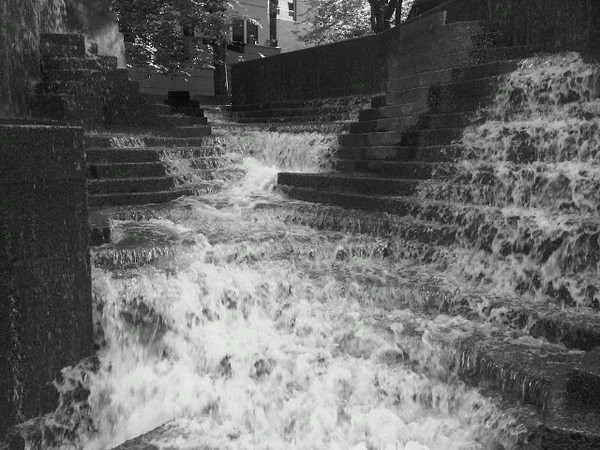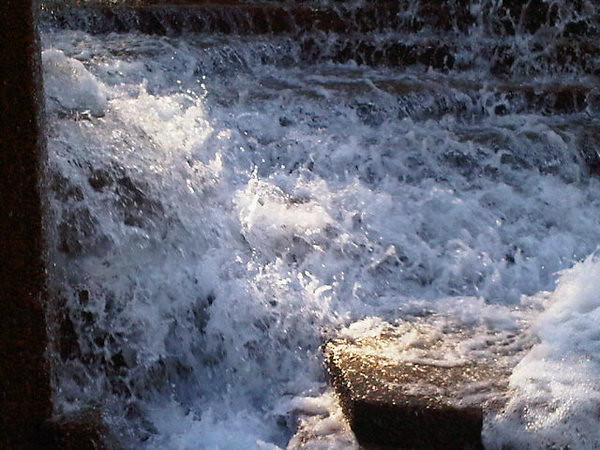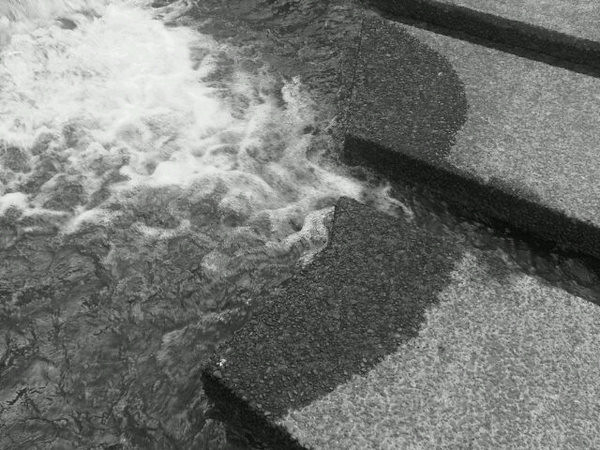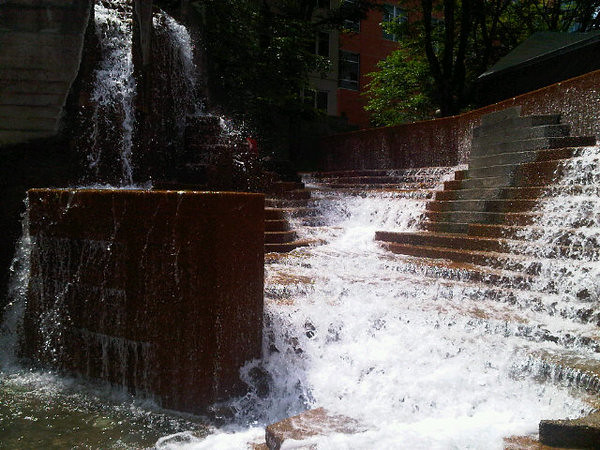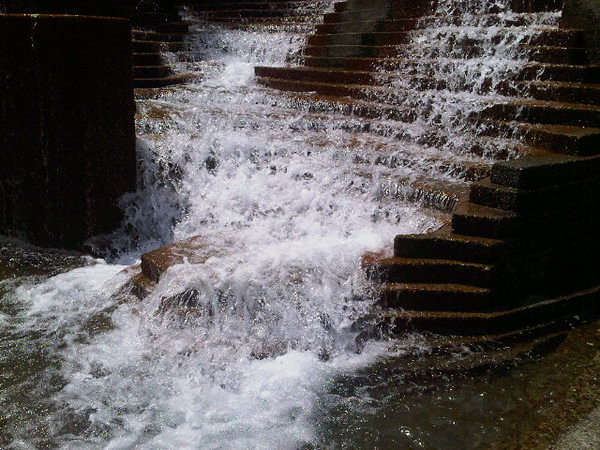Some months ago I realized a new incarnation of the legendary
This panel was created by Portland sculptor James Lee Hansen, whose work has appeared here a few times before, most recently in a July post about his Autumn Rider, located (a bit incongruously) at a shopping center in Gresham. As for our current subject, Hansen's website just calls it Harrison Square Relief Panel, and the only other info about it I could find on the interwebs comes to us from the July 8th, 1973 Oregonian, which ran a a photo of the freshly-unveiled art. The photo caption is brief but informative:
HANSEN SCULPTURE INSTALLED —- Becky Smith views new sculpture by James Hansen on main floor foyer wall of new First Harrison Square building. Commissioned by Jack J. Saltzman, the work is composed of nine sections, some in polished steel, some in steel given blue, yellow, and black automotive lacquer finishes. Hansen did bronze “Shaman” in front of State Highway Building on East Capitol Campus in Olympia in 1971.
So, working with automotive paint on steel is a cool idea. It occurs to me that it may have been easier to do this in 1973 than it is today; Hansen had the good fortune to be working at a time when cars came in lots of colors, which is not something new car buyers seem to want anymore in 2024. It seems like everyone wants to buy the largest, most threatening truck or SUV they can afford, and they only want them in the blandest colors available: black, white, grey, or beige. Like they're going for the Secret Service VIP motorcade look: Tough and official, and yet not drawing attention to your specific vehicle. I mean, I say that but I just bought a new car earlier this year (a fast little hatchback, not a chonky SUV), and the only available colors that I liked were blue and black, and I somewhat preferred the blue, but they had a black one on the lot while blue would have to be a special order that wouldn't be ready for months, so I got the black one. And the free market will undoubtedly chalk that up as yet another vote against cars coming in colors. ¯\_(ツ)_/¯
While looking for that one photo caption, I ran across a number of other vintage news articles about the then-new building that I thought were interesting. So it's time to bust out that Multnomah County library card again, and put on your best disco boots, because here we go...
- 1971, the design for the building was unveiled with great fanfare. One of the last developable blocks in the South Auditorium district
- August 18th & 19th articles on the groundbreaking for the new complex. The second story includes a photo of Mayor Terry Schrunk and Mayor-elect Neil... er, the guy we don't talk about.
- A 1972 photo of the complex under construction, along with a few other cutting-edge modern buildings like the Lincoln Tower condos, a few blocks further south on 1st
- July 1972 photo from the topping-out of the building, featuring pine trees in planters being emplaced by crane. Content warning: The photo also features that one creepy mayor whose name has fortunately been lost to history.
- In other 1972 announcements, the new building would soon be home to a swanky new fine dining restaurant. Which led me to several other stories about the Portland fine dining scene in the 1970s. Which was just as groovy as you'd expect, but just a bit off topic for this post, so I moved all that stuff down to footnote 2.
- The building won a Portland AIA award in June 1973
- October 1974 profile of the main developer behind the complex. The article helpfully explains that "entrepreneur" is a fancy new synonym for "hustler", a word people used to mean as a compliment back in the good old days.
- June 1975: One of the anchor tenants was the local office of Xerox Corp., and they were currently showcasing the shiny new Xerox 9200, a large, cutting-edge photocopying system. These would have been built at the Xerox campus in Silicon Valley, while somewhere in the same complex the company's research division was hard at work on the Xerox Alto, the first computer system with a modern GUI. Which was a revolutionary idea, but one that Xerox made approximately zero dollars from, even as Steve Jobs & Co. wandered around the lab making detailed notes on everything they saw.
- In 1976, the building took part in a previous episode of mural mania here; they went by "supergraphics" at the time. This was seen as a cheap way to liven up the city's recent crop of modern buildings. Which feels like a bit of an indictment of 1970s architecture -- it's only 3 years old and already needs livening up?
- An article about some other art installed around the same time as the Relief Panel, & designed by a local artist, brutalist concrete planters outside the main entrance to the building. I don't think they're there anymore, though I also usually don't pay much attention to concrete planters, so I may have to check again next time I'm getting coffee.
1. Coffee
Yelp reviews for the previous location on SW 5th between Washington & Alder. 2012 Willamette Week article called them "universally beloved", but then they had gelato at the time, and I'm not sure the new location does. A 2016 article said they had the best coffee in the city (which is kind of a big deal), and imagined it as a sort of caffeinated wormhole connected directly to Rome or Milan. A 2009 Oregonian piece -- when they were still a humble food cart -- also crowned them the best coffee place in town, serving the best gelato in town.
An April 2023 Portland Monthly article on best local coffee places mentions a place out in the Rose City Park neighborhood that uses Spella beans, as a place you can get the coffee without making the trek to the downtown-ish mothership. At some point in the last decade the local media ecosystem collectively decided their readers live on the eastside, and things downtown are now a trek instead of having a convenient central location. Possibly right around the time living close in on the westside (or at least in a trendy or trend-adjacent corner of the westside, i.e. the Pearl, South Waterfront, or NW Portland) became unaffordable on a print media paycheck. This is an unusual development, possibly the first time it's been this way.
- December 1972 Journal article on the planned Georges III, an upcoming swanky restaurant planned for Harrison Square, by one of the co-owners of The Captain's Corner, the big movers-and-shakers restaurant of the day. He mentioned that startup costs were expected to run around $200k in 1973 dollars, or around $1.4M today.
- 1973 piece insisting South Auditorium was on the verge of becoming a trendy neighborhood. The new Harrison Square complex was going to get a new fancy restaurant, joining a surprisingly long (as in, nonzero) list of neighborhood restaurants.
- To give you some idea of what a swanky restaurant was like in those days, here's an article from a few months later about The Captain's Corner, where the marquee menu item was the steak & lobster combo ($8.75, or $60.66 in 2023 dollars), which I gather was a bit of premium over the many other surf-n-turf joints around town. Other menu items included chicken livers with wine & mushroom sauce ($4.25 then, $29.26 now), bacon-wrapped scallops in white wine sauce ($4.75 / $32.93) and shrimp curry Bombay ($4.95 / $34.31). The Georges III article above notes that Captain's Corner still employed three of the original Captain's Corner Girls. It doesn't elaborate on what was involved in being a Captain's Corner Girl, but just going by the year it probably had something to do with cocktails or cigars, plus cleavage.
- 1974 review of Georges III. We're told the restaurant was superb, with an affordable and relatively adventurous menu by early 70s standards, including such exotic dishes as "prawns Genoa" and "baked oysters Ralston", whatever those are, or were. You could even order l'escargots if you were up for a walk on the wild side (the reviewer wasn't), and the old standbys like cream of mushroom soup were prepared fresh in house, and the whole bill came to $25.25 for cocktails, wine, dinner, and dessert for three people. At one point the reviewer marvels at the the location:
Where this once was a rundown, ugly area, there is this sparkling park-like situation, handsome buildings, Portland's most concentrated area of fine apartments, and just generally a sense of well-being.
- A positive review of Georges Three from October 1977 (they had dropped the roman numerals in favor of "Three" a couple of years earlier; maybe they figured a name too much like "George III" was a bad look with the Bicentennial coming up). But within two years it was gone, replaced by a ribs place called "Fast Eddie's", which seems to have stuck around until around 1983, and as far as I know that was the last food or beverage business in the building until Spella arrived in early 2023 or late 2022. Meanwhile, Captain's Corner got a largely negative review in October 1978 and was still open a decade layer. Though at this point it's been gone for decades too.
- One last item and we're done with this restaurant rabbit hole. As of October 1970, the Oregonian still had a section of the paper called "Women's News", as it had been for decades, but on October 12th the headline story concerned an upcoming womens' equality conference. One of the accompanying photos shows a Captain's Corner waitress chatting with a local rep from the local AFL-CIO Waitresses' Union. Another story on the same page relays some remarks by a (female) judge in the state family court system cautioning readers that getting divorced is not all just fun and games; it's expensive, time consuming, and blended families are weird and complicated, and won't someone please think of the children, basically.
